 This book is dedicated to: My family, for always encouraging me while Im under tight deadlines! Copyright Copyright 2016 by Jody Long All rights reserved. Bibliographical NoteAdorable Baby Knits: 25 Patterns for Boys and Girls is a new work, first published by Dover Publications, Inc., in 2016. International Standard Book NumberISBN-13: 978-0-486-80739-3ISBN-10: 0-486-80739-8 Manufactured in the United States by LSC Communications 80739801 2016 www.doverpublications.com CONTENTSINTRODUCTION There is always great joy amongst family and friends when they hear someone is expecting a baby! In this book you will find the perfect garment or accessory to knit for any brand-new bundle of joy or little one celebrating a first birthday, as all the patterns in this book go from newborn to 18 months. With the trends of today, baby showers are becoming the rage and there is nothing more satisfying than receiving a handmade garment knowing that each stitch was made with love and care. The garments range from basic (skill level: one star) to more difficult (skill level: three stars), making this the perfect baby book for all levels of knitters. The main goal of designing this book was to make sure there was plenty of ease in the garments for no-fuss dressing, and most importantly all the yarns are machine washable, making them easy to care for.
This book is dedicated to: My family, for always encouraging me while Im under tight deadlines! Copyright Copyright 2016 by Jody Long All rights reserved. Bibliographical NoteAdorable Baby Knits: 25 Patterns for Boys and Girls is a new work, first published by Dover Publications, Inc., in 2016. International Standard Book NumberISBN-13: 978-0-486-80739-3ISBN-10: 0-486-80739-8 Manufactured in the United States by LSC Communications 80739801 2016 www.doverpublications.com CONTENTSINTRODUCTION There is always great joy amongst family and friends when they hear someone is expecting a baby! In this book you will find the perfect garment or accessory to knit for any brand-new bundle of joy or little one celebrating a first birthday, as all the patterns in this book go from newborn to 18 months. With the trends of today, baby showers are becoming the rage and there is nothing more satisfying than receiving a handmade garment knowing that each stitch was made with love and care. The garments range from basic (skill level: one star) to more difficult (skill level: three stars), making this the perfect baby book for all levels of knitters. The main goal of designing this book was to make sure there was plenty of ease in the garments for no-fuss dressing, and most importantly all the yarns are machine washable, making them easy to care for.
Happy knitting! Jody Long How to Substitute Yarns Throughout this book, several different brands and weights of yarn have been used. Always knit a gauge swatch in the new yarn to match the stated gauge in the pattern. It is extremely simple to find a substitute yarn by using this simple equation. If the garment youre going to knit takes seven 3.52oz/100g balls of yarn, which has the yardage of 322/295m, and your new substitute yarn has a yardage of 197/180m, you will need to divide the recommended yarn length total by the new yarn of 197 = balls required. e.g.: 7 x 322yds = 2,254yds needed (recommended). 2,254yds divided by new yarn, which is 197yds, equals 11.44, so you will need twelve 3.52oz/100g balls to complete your garment using the new yarn.
I recommend always substituting with the same or similar weight yarn to avoid problems. Amount of Yarn Yarn amounts specified in the patterns can never be absolutely correct. This is partly due to the fact that tensions vary according to the knitter, but mostly because the number of yards/meters per ounce/gram varies with every color of yarn. To ensure that you will not run out of yarn, the yarn amounts given in the patterns are generous. EquipmentSewing needle: Always use a wool (knitters) sewing needle for sewing up as these tend to be blunt and will not split the yarn fiber or stitches, resulting in a neater seam. Stitch holders: These prevent stitches from unravelling when not in use.
Alternately, a spare knitting needle of the same size or less (ideally a double pointed) can be used as a stitch holder. For holding just a few stitches, a safety pin is always useful. Cable needle: There are two types of cable needles: one has a kink and the other is straight, similar to a double-pointed needle. I recommend the one with the kink, as this prevents the stitches from sliding off the needle. Gauge It is important to check your tension before you start knitting. Knit a swatch using the specified yarn and knitting needles.
If there are too many stitches to 4in/10cm, your tension is tight and you should change to a larger-sized needle. If there are too few stitches, your tension is loose and you should change to a smaller-sized needle. Casting On (Cable Method) Although there are many different techniques for casting on stitches, the following method creates a firm and attractive edge: (1) Make a slip knot in the yarn and place the loop on the left-hand needle. Insert the point of the right-hand needle into the loop on the left-hand needle, wind the yarn round the right-hand needle, and draw the yarn through the loop. Pass the new loop onto the left-hand needle and pull the yarn to tighten the new loop. (2) Insert the right-hand needle between the two loops on the left-hand needle, wind the yarn around the right-hand needle, and draw the yarn through.
Slip the new loop onto the left-hand needle as before. (3) Continue in this way, inserting the needle between two loops on the left-hand needle, until you have the required number of stitches. Basic Stitches Here is how to work the simple stitches used for the garments: Stockinette Stitch: Alternate one row knit and one row purl. The knit side is the right side of the work unless otherwise stated in the instructions. Garter Stitch: Knit every row. K1, P1 Rib: Alternate one knit stitch with one purl stitch to the end of the row. K1, P1 Rib: Alternate one knit stitch with one purl stitch to the end of the row.
On the next row, knit all the knit stitches and purl all the purl stitches as they face you. Seed Stitch: Alternate one knit stitch with one purl stitch to the end of the row. On the next row, knit all the purl stitches and purl all the knit stitches as they face you. Joining Yarn Always join yarn at the beginning of a new row (unless youre working the Fair Isle or Intarsia Method) and never knot the yarn, as the knot may come through to the right side and spoil your work. Any long loose ends will be useful for sewing up afterwards. Working from a Chart Each square on a chart represents a stitch and each line of squares a row of knitting. Working from a Chart Each square on a chart represents a stitch and each line of squares a row of knitting.
Alongside the chart there will be a color key. When working from the charts, read odd rows (knit) from right to left and even rows (purl) from left to right, unless otherwise stated. Seams I recommend mattress stitch, as this helps matching row for row and stripe for stripe on knitted fabric. If you are unable to mattress stitch, then a simple backstitch will be fine. Whichever method you choose for sewing your garment together, a one-stitch seam allowance has been given on all pieces. Numbers in Brackets The smallest size is always the first set of numbers just before the opening bracket with the larger sizes inside before the closing of the bracket. Numbers in Brackets The smallest size is always the first set of numbers just before the opening bracket with the larger sizes inside before the closing of the bracket.
Where there is only one number without brackets, this is for all sizes. Binding Off Always bind off knit-wise unless otherwise stated. Working in Stockinette Stitch Always begin with a K row unless otherwise stated. USUK CONVERSION
US
NEEDLE CONVERSION | UK |
| 0 | 2.00 |
| 1 | 2.25 |
| 2.50 |
| 2 | 2.75 |
| 2 | 3.00 |
| 3 | 3.25 |
| 4 | 3.50 |
| 5 | 3.75 |
| 6 | 4.00 |
| 7 | 4.50 |
| 8 | 5.00 |
| 9 | 5.50 |
| 10 | 6.00 |
| 10.5 | 6.50 |
| 7.00 |
| 7.50 |
| 11 |
Next page
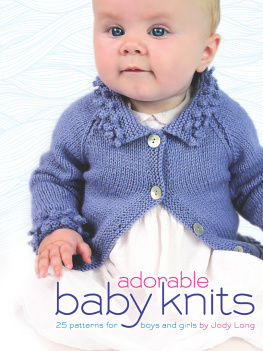







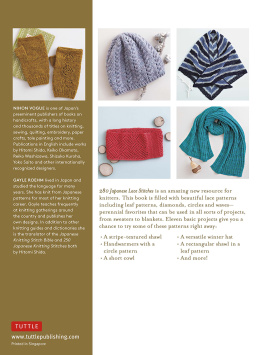
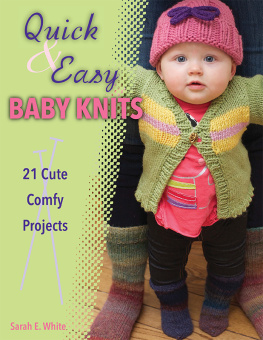
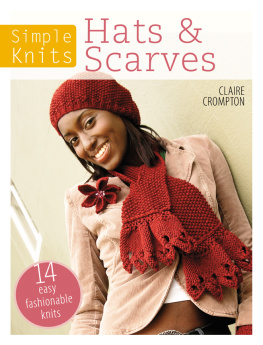
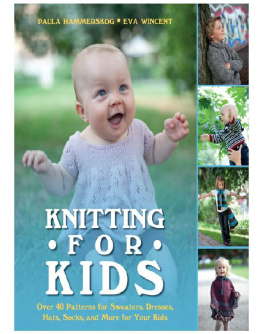
 This book is dedicated to: My family, for always encouraging me while Im under tight deadlines! Copyright Copyright 2016 by Jody Long All rights reserved. Bibliographical NoteAdorable Baby Knits: 25 Patterns for Boys and Girls is a new work, first published by Dover Publications, Inc., in 2016. International Standard Book NumberISBN-13: 978-0-486-80739-3ISBN-10: 0-486-80739-8 Manufactured in the United States by LSC Communications 80739801 2016 www.doverpublications.com CONTENTSINTRODUCTION There is always great joy amongst family and friends when they hear someone is expecting a baby! In this book you will find the perfect garment or accessory to knit for any brand-new bundle of joy or little one celebrating a first birthday, as all the patterns in this book go from newborn to 18 months. With the trends of today, baby showers are becoming the rage and there is nothing more satisfying than receiving a handmade garment knowing that each stitch was made with love and care. The garments range from basic (skill level: one star) to more difficult (skill level: three stars), making this the perfect baby book for all levels of knitters. The main goal of designing this book was to make sure there was plenty of ease in the garments for no-fuss dressing, and most importantly all the yarns are machine washable, making them easy to care for.
This book is dedicated to: My family, for always encouraging me while Im under tight deadlines! Copyright Copyright 2016 by Jody Long All rights reserved. Bibliographical NoteAdorable Baby Knits: 25 Patterns for Boys and Girls is a new work, first published by Dover Publications, Inc., in 2016. International Standard Book NumberISBN-13: 978-0-486-80739-3ISBN-10: 0-486-80739-8 Manufactured in the United States by LSC Communications 80739801 2016 www.doverpublications.com CONTENTSINTRODUCTION There is always great joy amongst family and friends when they hear someone is expecting a baby! In this book you will find the perfect garment or accessory to knit for any brand-new bundle of joy or little one celebrating a first birthday, as all the patterns in this book go from newborn to 18 months. With the trends of today, baby showers are becoming the rage and there is nothing more satisfying than receiving a handmade garment knowing that each stitch was made with love and care. The garments range from basic (skill level: one star) to more difficult (skill level: three stars), making this the perfect baby book for all levels of knitters. The main goal of designing this book was to make sure there was plenty of ease in the garments for no-fuss dressing, and most importantly all the yarns are machine washable, making them easy to care for.